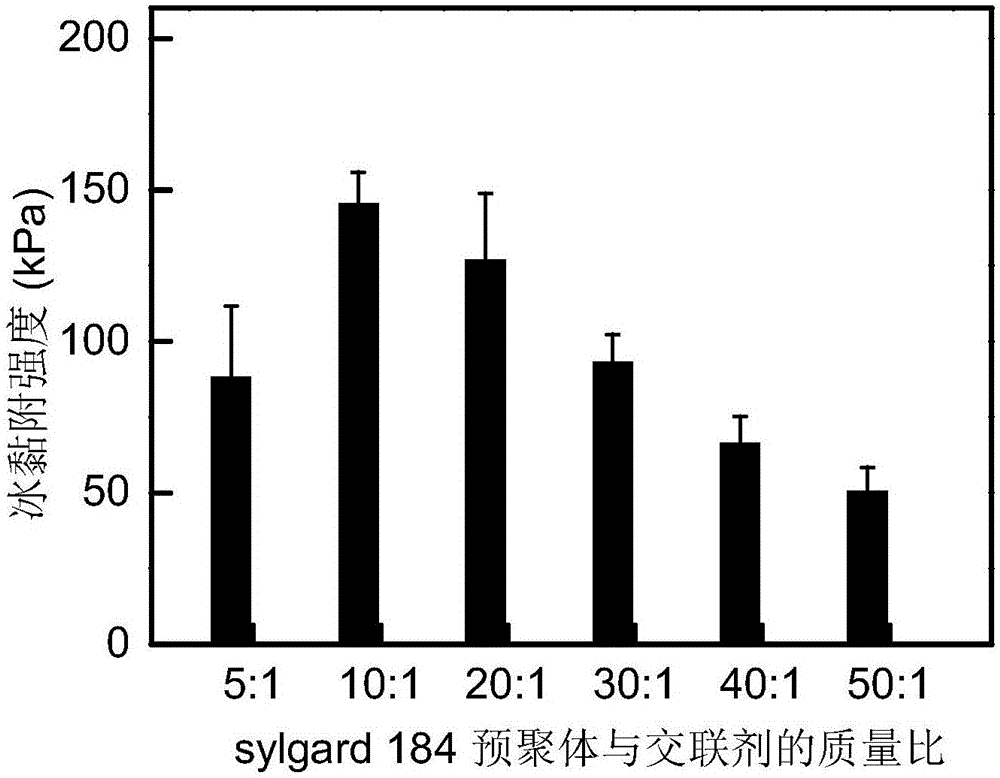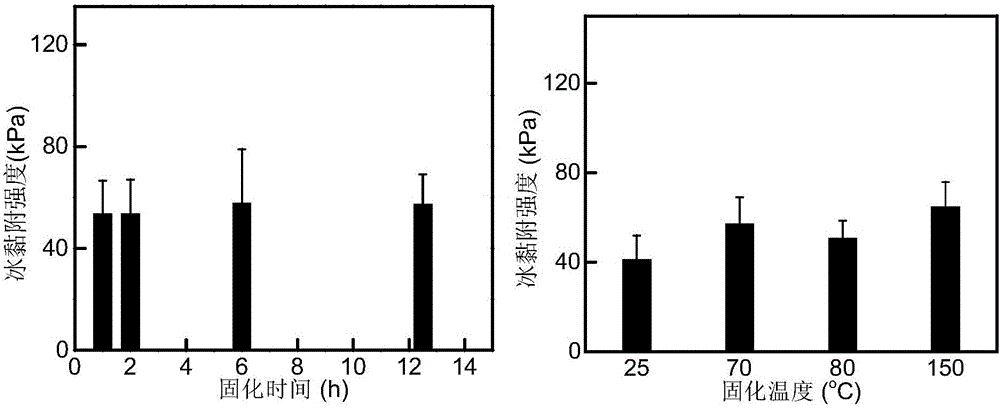Low-ice-adhesion anti-icing coating, and preparation method and application thereof
A technology of anti-icing and adhesion, applied in coatings, polyurea/polyurethane coatings, etc., can solve problems such as loss of lubricating layer, high cost of antifreeze protein preparation, environmental hazards, etc.
- Summary
- Abstract
- Description
- Claims
- Application Information
AI Technical Summary
Problems solved by technology
Method used
Image
Examples
preparation example Construction
[0057] As mentioned above, the present invention provides a kind of preparation method of the anti-icing coating of low ice adhesion, in a preferred embodiment of the present invention, the specific preparation method of described anti-icing coating comprises:
[0058] (1) Dissolve a certain ratio (stoichiometric or excess) of prepolymers and cross-linking agents with free chain components (may not be added), or a certain mass of long-chain polymers, mix evenly, and centrifuge at 6000r / min for 10min , vacuumize in a vacuum oven for 0.5h to remove air bubbles to obtain the anti-icing coating;
[0059] (2) coating the coating in step (1) after removing air bubbles on the surface of the cleaned substrate, leveling it into a film layer with a uniform thickness of 0.01 to 2.5 mm, and curing it by heat (or ultraviolet curing) to obtain the described Anti-icing coating.
[0060] In the present invention, the curing temperature is controlled at 25-70°C and the curing time is controll...
Embodiment 1
[0070] The mass ratio of prepolymer and crosslinking agent in Sylgard 184 was changed to reduce the modulus of polymer elastic network, so as to achieve low ice adhesion of anti-icing coating. The free chain is an excess of siloxane prepolymer or crosslinking agent.
[0071] Mix the prepolymer and crosslinking agent in Sylgard 184 according to the mass ratio of 5:1, 10:1, 20:1, 30:1, 40:1, 50:1, centrifuge at 6000r / min for 10min, and dry in vacuum Vacuum the box for 30 min to remove air bubbles.
[0072] Using a clean silicon wafer as the base material, spread it on a Petri dish, level it into a coating of about 1.6mm, and cure it at 70°C for 12.5 hours to obtain an anti-icing coating with low ice adhesion.
[0073] When the ambient temperature is -30°C and the ambient humidity is 50%, freeze for 5 hours to test its anti-icing performance.
[0074] The results show that: by figure 1 It can be seen that when the ratio of siloxane prepolymer to crosslinking agent is 10:1, the...
Embodiment 2
[0076] The temperature and time of the crosslinking reaction between the siloxane prepolymer and the crosslinking agent in Sylgard 184 were changed to adjust the modulus of the polymer elastic network, and the influence on the low ice adhesion of the anti-icing coating was studied. The free chain is an excess of siloxane prepolymer.
[0077] Mix the siloxane prepolymer and crosslinking agent in Sylgard 184 evenly at a mass ratio of 50:1, centrifuge at 6000r / min for 10min, and vacuumize in a vacuum drying oven for 30min to remove air bubbles.
[0078] (1) Use a clean silicon wafer as the base material, spread it in a petri dish, level it into a coating of about 1.6mm, and cure it at 70°C for 1h to 12.5h to obtain an anti-icing coating.
[0079] (2) Use a clean silicon wafer as the substrate, spread it in a petri dish, level it into a coating of about 1.6mm, and cure it at 25°C, 70°C, 80°C, and 150°C for 12.5 hours to obtain an anti-icing coating layer.
[0080] When the ambie...
PUM
| Property | Measurement | Unit |
|---|---|---|
| Thickness | aaaaa | aaaaa |
| Thickness | aaaaa | aaaaa |
| Viscosity | aaaaa | aaaaa |
Abstract
Description
Claims
Application Information
 Login to View More
Login to View More - R&D
- Intellectual Property
- Life Sciences
- Materials
- Tech Scout
- Unparalleled Data Quality
- Higher Quality Content
- 60% Fewer Hallucinations
Browse by: Latest US Patents, China's latest patents, Technical Efficacy Thesaurus, Application Domain, Technology Topic, Popular Technical Reports.
© 2025 PatSnap. All rights reserved.Legal|Privacy policy|Modern Slavery Act Transparency Statement|Sitemap|About US| Contact US: help@patsnap.com



